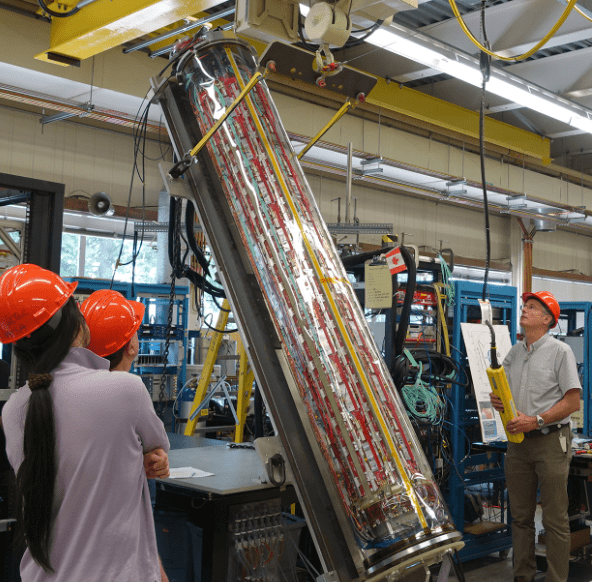The ALPHA collaboration is an international team of researchers who study antihydrogen. They have built a detector that will determine the mass and gravitational effects on antimatter hydrogen.
They will produce very precise measurements of physical characteristics and behavior of antimatter.
The detector has been sent to CERN. The CERN particle accelerator is the only place where enough antimatter is produced for testing.
CERN will shutdown after November for two years of maintenance. In July, ALPHA-g was shipped via cargo plane to CERN.
They will shine laser beams on trapped antihydrogen atoms. ALPHA uses a system of magnetic traps that allow antihydrogen atoms to be produced and stored long enough for study.
The cooling cryostat was designed and built at TRIUMF and the University of Calgary.
Antimatter Gravity Experiment
Magnetic fields at the top and bottom lids will open at the exact same time. Antihydrogen will be observed in the presence of Earth’s gravitational field. They will see if antihydrogen atoms fall down like regular matter—or move upward, defying gravity altogether.
Antigravity for antimatter is extremely unlikely. But, if antigravity is observed then physics will be completely upended. If there is any difference in antimatter gravity behavior there will be a breakthrough in physics.
This experiment will be repeated with more precise measurements of the gravitational effects of antimatter once CERN reopens in two years. Researchers hope to at least observe whether antimatter goes up or down before the facility shuts down for maintenance.
This is new technology and creating the antihydrogen from positrons and antiprotons is difficult.
The wiring has shorted out once already. It took a week of delicate work to repair.
They get neutral antihydrogen atoms by taking antiprotons from the Antiproton Decelerator (AD) and binding them with positrons from a sodium-22 source. ALPHA confines the resulting neutral antihydrogen atoms in a magnetic trap and shines laser light or microwaves onto them to measure their internal structure. The ALPHA-g experiment has the same type of apparatus for making and trapping antiatoms, except that it is oriented vertically. With this vertical set-up, researchers can precisely measure the vertical positions at which the antihydrogen atoms annihilate with normal matter once they switch off the trap’s magnetic field and the atoms are under the sole influence of gravity. The values of these positions will allow them to measure the effect of gravity on the antiatoms.
The GBAR experiment creates neutral antihydrogen with a different method. It uses antiprotons from the ELENA deceleration ring. Positrons are produced by a small linear accelerator to make antihydrogen ions. The ions have one antiproton and two positrons.The antihydrogen ions are trapped and chilled to about 10 microkelvin. A laser strips the ion of one positron. This changes them to neutral antiatoms. The neutral antiatoms will be released from the trap and allowed to fall from a height of 20 centimeters.

History of antimatter
The first nine antihydrogen atoms were made in 1995. Those antimatter atoms only lasted for 40 billionths of a second.
In 2018, CERN can have a thousand antihydrogen atoms at once in the Alpha-2 machine.
The antimatter counterpart of every matter particle should have:
the same mass, [inertial mass is known]
the same acceleration in a gravitational field, [unknown]
the opposite electric charge [known],
the opposite spin [known],
the same magnetic properties,
should bind together the same way into atoms, molecules and larger structures [partially known],
and should have the same spectrum of positron transitions in those varied configurations.
The known properties are antimatter’s inertial mass, electric charge, spin and magnetic properties. Its binding and transitional properties have been measured by other detectors at the ALPHA experiment, and line up with what particle physics predicts.

Brian Wang is a Futurist Thought Leader and a popular Science blogger with 1 million readers per month. His blog Nextbigfuture.com is ranked #1 Science News Blog. It covers many disruptive technology and trends including Space, Robotics, Artificial Intelligence, Medicine, Anti-aging Biotechnology, and Nanotechnology.
Known for identifying cutting edge technologies, he is currently a Co-Founder of a startup and fundraiser for high potential early-stage companies. He is the Head of Research for Allocations for deep technology investments and an Angel Investor at Space Angels.
A frequent speaker at corporations, he has been a TEDx speaker, a Singularity University speaker and guest at numerous interviews for radio and podcasts. He is open to public speaking and advising engagements.


If Antimatter had negative mass may mean that inertial mass and gravity mass are not always equivalent.
If antimatter had negative mass, its inertial mass would be negative as well, making it move in opposite direction of the gravitational force. This means that it would fall down like matter with positive mass. The only difference would be that the antimatter pushes thecEartha away a little bit, meaning that it would fall a little bit slower. The difference is imo impossible to measure.
If Antimatter had negative mass may mean that inertial mass and gravity mass are not always equivalent.
Looks like the first “Warp Core”
Looks like the first “Warp Core”